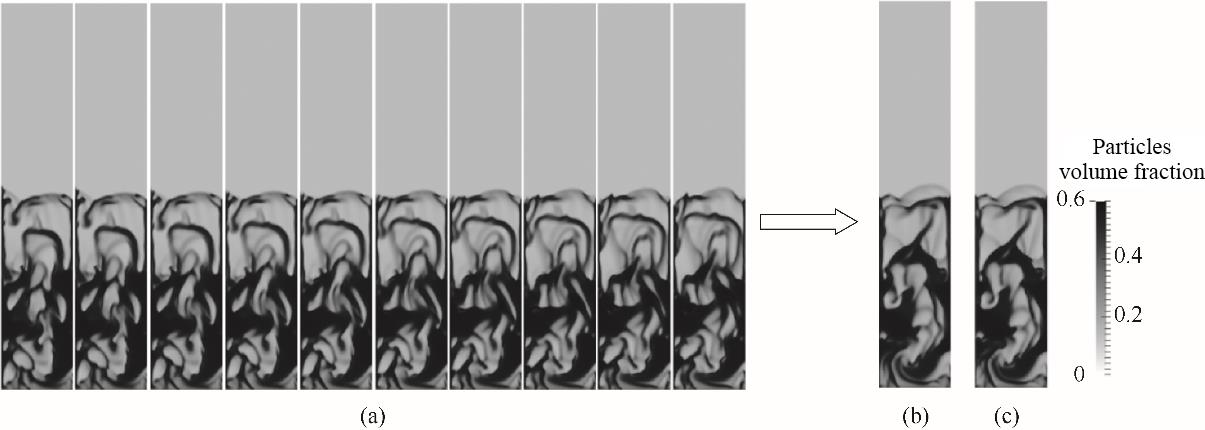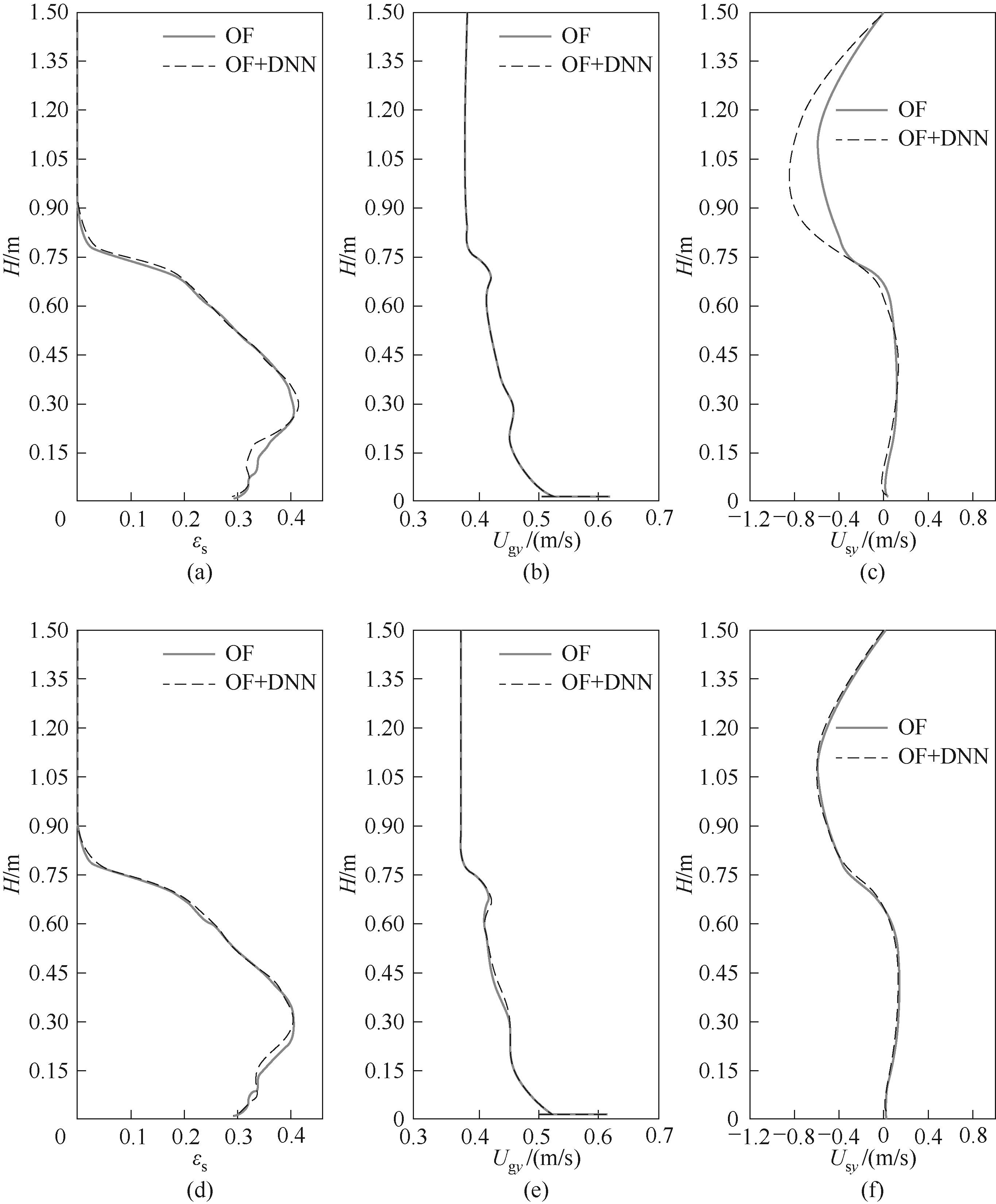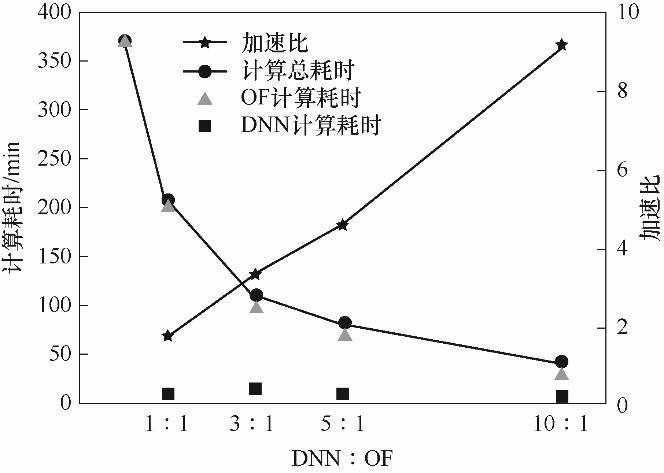化工学报 ›› 2023, Vol. 74 ›› Issue (9): 3775-3785.DOI: 10.11949/0438-1157.20230711
温凯杰1,2( ), 郭力1,2, 夏诏杰1,2, 陈建华1(
), 郭力1,2, 夏诏杰1,2, 陈建华1( )
)
收稿日期:2023-07-10
修回日期:2023-09-02
出版日期:2023-09-25
发布日期:2023-11-20
通讯作者:
陈建华
作者简介:温凯杰(1998—),女,硕士研究生,wenkaijie21@mails.ucas.ac.cn
基金资助:
Kaijie WEN1,2( ), Li GUO1,2, Zhaojie XIA1,2, Jianhua CHEN1(
), Li GUO1,2, Zhaojie XIA1,2, Jianhua CHEN1( )
)
Received:2023-07-10
Revised:2023-09-02
Online:2023-09-25
Published:2023-11-20
Contact:
Jianhua CHEN
摘要:
在计算流体力学领域,深度学习被用于重建流场、预测曳力、求解泊松方程、加速流体模拟等方面的研究。为了加速气固两相流的模拟计算,使用卷积长短时记忆网络对物理量进行预测,并基于LibTorch实现深度学习模型预测与OpenFOAM的耦合。通过与单纯OpenFOAM模拟结果对比,发现深度学习模型预测存在颗粒体积分数不守恒、极小数值预测不准确的问题,先后通过体积分数校正和网格数据过滤消除了前述影响。选取不同的三个物理量组合进行深度学习模型预测以加速CFD计算,在同样选取颗粒体积分数和气体速度的条件下,对比了增加预测颗粒速度和压力对耦合流程计算结果的影响,其中,增加预测颗粒速度的计算结果较为准确,经分析发现这可能与求解器对不同变量的调用顺序有关。此外,研究了不同深度学习模型预测跨度比(1∶1、3∶1、5∶1、10∶1)下的耦合计算结果以及加速效果,发现在一定误差范围内,当前耦合计算流程最高可实现9倍左右的加速,且加速比与跨度比呈近似线性关系。
中图分类号:
温凯杰, 郭力, 夏诏杰, 陈建华. 一种耦合CFD与深度学习的气固快速模拟方法[J]. 化工学报, 2023, 74(9): 3775-3785.
Kaijie WEN, Li GUO, Zhaojie XIA, Jianhua CHEN. A rapid simulation method of gas-solid flow by coupling CFD and deep learning[J]. CIESC Journal, 2023, 74(9): 3775-3785.
| 变量 | 数值 |
|---|---|
| 颗粒直径(dp)/µm | 275 |
| 固相密度(ρs)/(kg/m3) | 2500 |
| 气相密度(ρg)/(kg/m3) | 1.225 |
| 气相黏度(μg)/(Pa·s) | 1.84×10-5 |
| 反应器尺寸/m | 0.28×1.5 |
| 床层高度/m | 0.4 |
| 网格数量 | 56×300 |
| 模拟时间步长/s | 2×10-4 |
| 写入文件时间步长/s | 0.01 |
| 总模拟时长/s | 10 |
表1 模拟体系主要参数
Table 1 Main parameters of the simulation
| 变量 | 数值 |
|---|---|
| 颗粒直径(dp)/µm | 275 |
| 固相密度(ρs)/(kg/m3) | 2500 |
| 气相密度(ρg)/(kg/m3) | 1.225 |
| 气相黏度(μg)/(Pa·s) | 1.84×10-5 |
| 反应器尺寸/m | 0.28×1.5 |
| 床层高度/m | 0.4 |
| 网格数量 | 56×300 |
| 模拟时间步长/s | 2×10-4 |
| 写入文件时间步长/s | 0.01 |
| 总模拟时长/s | 10 |
| Name | Type | Kernel | Stride | Padding | Ch I/O |
|---|---|---|---|---|---|
| Encoder | CNN | 3×3 | 1×1 | 1×1 | 5/16 |
| ConvLSTM | 3×3 | 1×1 | 1×1 | 16/64 | |
| CNN | 3×3 | 2×2 | 1×1 | 64/64 | |
| ConvLSTM | 3×3 | 1×1 | 1×1 | 64/96 | |
| CNN | 3×3 | 2×2 | 1×1 | 96/96 | |
| ConvLSTM | 3×3 | 1×1 | 1×1 | 96/96 | |
| Forecast | ConvLSTM | 3×3 | 1×1 | 1×1 | 96/96 |
| CNN | 4×4 | 2×2 | 1×1 | 96/96 | |
| ConvLSTM | 3×3 | 1×1 | 1×1 | 96/96 | |
| CNN | 4×4 | 2×2 | 1×1 | 96/96 | |
| ConvLSTM | 3×3 | 1×1 | 1×1 | 96/64 | |
| CNN | 3×3 | 1×1 | 1×1 | 64/16 | |
| CNN | 1×1 | 1×1 | 0×0 | 16/5 |
表2 神经网络参数
Table 2 Parameters of the neural network
| Name | Type | Kernel | Stride | Padding | Ch I/O |
|---|---|---|---|---|---|
| Encoder | CNN | 3×3 | 1×1 | 1×1 | 5/16 |
| ConvLSTM | 3×3 | 1×1 | 1×1 | 16/64 | |
| CNN | 3×3 | 2×2 | 1×1 | 64/64 | |
| ConvLSTM | 3×3 | 1×1 | 1×1 | 64/96 | |
| CNN | 3×3 | 2×2 | 1×1 | 96/96 | |
| ConvLSTM | 3×3 | 1×1 | 1×1 | 96/96 | |
| Forecast | ConvLSTM | 3×3 | 1×1 | 1×1 | 96/96 |
| CNN | 4×4 | 2×2 | 1×1 | 96/96 | |
| ConvLSTM | 3×3 | 1×1 | 1×1 | 96/96 | |
| CNN | 4×4 | 2×2 | 1×1 | 96/96 | |
| ConvLSTM | 3×3 | 1×1 | 1×1 | 96/64 | |
| CNN | 3×3 | 1×1 | 1×1 | 64/16 | |
| CNN | 1×1 | 1×1 | 0×0 | 16/5 |
| Physical quantity | MSE | PSNR |
|---|---|---|
| εs | 6.67×10-4 | 31.76 |
| Ugx | 1.04×10-5 | 49.83 |
| Ugy | 1.69×10-5 | 47.72 |
| Usx | 1.53×10-5 | 48.15 |
| Usy | 2.37×10-5 | 46.25 |
表3 测试集上的模型性能
Table 3 Model performance on the test set
| Physical quantity | MSE | PSNR |
|---|---|---|
| εs | 6.67×10-4 | 31.76 |
| Ugx | 1.04×10-5 | 49.83 |
| Ugy | 1.69×10-5 | 47.72 |
| Usx | 1.53×10-5 | 48.15 |
| Usy | 2.37×10-5 | 46.25 |

图6 神经网络中εs物理场的输入(a)、预测的最后一帧(b)和目标(c)图像
Fig.6 Images of the input (a), the last predicted frame (b) and the corresponding target (c) of εs in the neural network

图10 深度学习模型预测εs、 Ug 、 Us 时固含率校正后的典型物理量轴向分布对比[(a)~(c)]及继续处理小量后的轴向分布对比[(d)~(f)]
Fig.10 Comparison of typical axial distribution after correction of solid volume fraction [(a)—(c)] and typical axial distribution after further treatment of very small values [(d)—(f)] when deep learning model predicts εs, Ug and Us

图13 不同深度学习模型预测跨度下耦合流程的计算耗时与加速比
Fig.13 Calculation time and acceleration ratio of coupling process under different deep learning model prediction spans
| 1 | Steyaert S, Pizurica M, Nagaraj D, et al. Multimodal data fusion for cancer biomarker discovery with deep learning[J]. Nature Machine Intelligence, 2023, 5(4): 351-362. |
| 2 | Chen X Y, Lv H L. Intelligent control of nanoparticle synthesis on microfluidic chips with machine learning[J]. NPG Asia Materials, 2022, 14: 69. |
| 3 | Yu T H, Boob A G, Volk M J, et al. Machine learning-enabled retrobiosynthesis of molecules[J]. Nature Catalysis, 2023, 6(2): 137-151. |
| 4 | Karagiorgi G, Kasieczka G, Kravitz S, et al. Machine learning in the search for new fundamental physics[J]. Nature Reviews Physics, 2022, 4(6): 399-412. |
| 5 | Vinuesa R, Brunton S L. Enhancing computational fluid dynamics with machine learning[J]. Nature Computational Science, 2022, 2(6): 358-366. |
| 6 | Zhu L T, Chen X Z, Ouyang B, et al. Review of machine learning for hydrodynamics, transport, and reactions in multiphase flows and reactors[J]. Industrial & Engineering Chemistry Research, 2022, 61(28): 9901-9949. |
| 7 | Brunton S L, Noack B R, Koumoutsakos P. Machine learning for fluid mechanics[J]. Annual Review of Fluid Mechanics, 2020, 52: 477-508. |
| 8 | Kim B, Azevedo V C, Thuerey N, et al. Deep fluids: a generative network for parameterized fluid simulations[J]. Computer Graphics Forum, 2019, 38(2): 59-70. |
| 9 | Fukami K, Fukagata K, Taira K. Super-resolution reconstruction of turbulent flows with machine learning[J]. Journal of Fluid Mechanics, 2019, 870: 106-120. |
| 10 | Yang Z, Lu B N, Wang W. Coupling artificial neural network with EMMS drag for simulation of dense fluidized beds[J]. Chemical Engineering Science, 2021, 246: 117003. |
| 11 | Muralidhar N, Bu J, Cao Z, et al. Physics-guided deep learning for drag force prediction in dense fluid-particulate systems[J]. Big Data, 2020, 8(5): 431-449. |
| 12 | Guo L, Wu J, Li J H. Complexity at mesoscales: a common challenge in developing artificial intelligence[J]. Engineering, 2019, 5(5): 924-929. |
| 13 | Maulik R, Sharma H, Patel S, et al. A turbulent eddy-viscosity surrogate modeling framework for Reynolds-averaged Navier-Stokes simulations[J]. Computers & Fluids, 2021, 227: 104777. |
| 14 | Tompson J, Schlachter K, Sprechmann P, et al. Accelerating eulerian fluid simulation with convolutional networks[C]//Proceedings of the 34th International Conference on Machine Learning. New York, NY, USA: ACM, 2017: 3424-3433. |
| 15 | Ajuria I E, Alguacil A, Bauerheim M, et al. Towards an hybrid computational strategy based on deep learning for incompressible flows[C]//Proceedings of the AIAA Aviation 2020 Forum. Reston, Virginia: AIAA, 2020: AIAA2020-3058. |
| 16 | Obiols-Sales O, Vishnu A, Malaya N, et al. CFDNet: a deep learning-based accelerator for fluid simulations[C]//Proceedings of the 34th ACM International Conference on Supercomputing. New York, NY, USA: ACM, 2020: 1-12. |
| 17 | Jeon J, Lee J, Kim S J. Finite volume method network for the acceleration of unsteady computational fluid dynamics: non-reacting and reacting flows[J]. International Journal of Energy Research, 2022, 46(8): 10770-10795. |
| 18 | Bazai H, Kargar E, Mehrabi M. Using an encoder-decoder convolutional neural network to predict the solid holdup patterns in a pseudo-2D fluidized bed[J]. Chemical Engineering Science, 2021, 246: 116886. |
| 19 | Shi X J, Gao Z H, Lausen L, et al. Deep learning for precipitation nowcasting: a benchmark and a new model[C]// Proceedings of the 31st International Conference on Neural Information Processing Systems. New York, NY, USA: Curran Associates Inc., 2017: 5622-5632. |
| 20 | Shi X J, Chen Z R, Wang H, et al. Convolutional LSTM network: a machine learning approach for precipitation nowcasting[C]//Proceedings of the 28th International Conference on Neural Information Processing Systems. Cambridge, MA, USA: MIT Press, 2015: 802-810. |
| 21 | Wang Y B, Long M S, Wang J M, et al. PredRNN: recurrent neural networks for predictive learning using spatiotemporal LSTMs[C]//Proceedings of the 31st International Conference on Neural Information Processing Systems. New York, NY, USA: Curran Associates Inc., 2017: 879–888. |
| 22 | Wang Y B, Gao Z F, Long M S, et al. PredRNN++: towards a resolution of the deep-in-time dilemma in spatiotemporal predictive learning[C]// Proceedings of the 35th International Conference on Machine Learning. New York, NY, USA: ACM, 2018: 5123-5132. |
| 23 | Yu B, Yin H T, Zhu Z X. Spatio-temporal graph convolutional networks: a deep learning framework for traffic forecasting[C]//Proceedings of the 27th International Joint Conference on Artificial Intelligence. Palo Alto, CA, USA: AAAI Press, 2018: 3634–3640. |
| 24 | Zhou S Y, Xie W H, Lu Y X, et al. ConvLSTM-based wave forecasts in the South and East China Seas[J]. Frontiers in Marine Science, 2021, 8: 680079. |
| 25 | Gonzalez F J, Balajewicz M. Deep convolutional recurrent autoencoders for learning low-dimensional feature dynamics of fluid systems[EB/OL]. 2018, arXiv: 1808.01346. . |
| 26 | Weiner A, Semaan R. flowTorch—a Python library for analysis and reduced-order modeling of fluid flows[J]. Journal of Open Source Software, 2021, 6(68): 3860. |
| 27 | Maulik R, Sharma H, Patel S, et al. Deploying deep learning in OpenFOAM with TensorFlow[C]//Proceedings of the AIAA Scitech 2021 Forum. Reston, Virginia: AIAA, 2021: AIAA2021-1485. |
| 28 | Jeon J, Lee J, Eivazi H, et al. Physics-informed transfer learning strategy to accelerate unsteady fluid flow simulations[EB/OL]. 2022, arXiv: 2206.06817. . |
| 29 | Lu L Q, Gao X, Dietiker J F, et al. Development of a filtered CFD-DEM drag model with multiscale markers using an artificial neural network and nonlinear regression[J]. Industrial & Engineering Chemistry Research, 2022, 61(1): 882-893. |
| 30 | Hochreiter S, Schmidhuber J. Long short-term memory[J]. Neural Computation, 1997, 9(8): 1735-1780. |
| 31 | 王雅琳, 潘雨晴, 刘晨亮. 基于GSA-LSTM动态结构特征提取的间歇过程监测方法[J]. 化工学报, 2022, 73(9): 3994-4002. |
| Wang Y L, Pan Y Q, Liu C L. Intermittent process monitoring based on GSA-LSTM dynamic structure feature extraction[J]. CIESC Journal, 2022, 73(9): 3994-4002. | |
| 32 | 刘立邦, 杨颂, 王志坚, 等. 基于改进WOA-LSTM的焦炭质量预测[J]. 化工学报, 2022, 73(3): 1291-1299. |
| Liu L B, Yang S, Wang Z J, et al. Prediction of coke quality based on improved WOA-LSTM[J]. CIESC Journal, 2022, 73(3): 1291-1299. | |
| 33 | Cho K, van Merrienboer B, Gulcehre C, et al. Learning phrase representations using RNN encoder–decoder for statistical machine translation[C]//Proceedings of the 2014 Conference on Empirical Methods in Natural Language Processing (EMNLP). Stroudsburg, PA, USA: Association for Computational Linguistics, 2014: 1724-1734. |
| 34 | van der Hoef M A, van Sint Annaland M, Deen N G, et al. Numerical simulation of dense gas-solid fluidized beds: a multiscale modeling strategy[J]. Annual Review of Fluid Mechanics, 2008, 40: 47-70. |
| 35 | Ishii M. Thermo-fluid Dynamic Theory of Two-phase Flow[M]. Paris: Evrolles, 1975. |
| 36 | Derivation Wachem B., implementation, and validation of computer simulation models for gas-solid fluidized beds[D]. Amsterdam: Delft University of Technology, 2000. |
| 37 | Taghipour F, Ellis N, Wong C. Experimental and computational study of gas-solid fluidized bed hydrodynamics[J]. Chemical Engineering Science, 2005, 60(24): 6857-6867. |
| 38 | Shin D, Gupta S K. A new circuit simplification method for error tolerant applications[C]//2011 Design, Automation & Test in Europe. Washington, DC, USA: IEEE, 2011: 1-6. |
| 39 | Moosazadeh M, Andalib A. A new robust color digital image watermarking algorithm in DCT domain using genetic algorithm and coefficients exchange approach[C]//2016 Second International Conference on Web Research (ICWR). Washington, DC, USA: IEEE, 2016: 19-24. |
| 40 | Shih T K, Chang R C, Lu L C, et al. Adaptive digital image inpainting[C]//18th International Conference on Advanced Information Networking and Applications. Washington, DC, USA: IEEE, 2004: 71-76. |
| [1] | 张思雨, 殷勇高, 贾鹏琦, 叶威. 双U型地埋管群跨季节蓄热特性研究[J]. 化工学报, 2023, 74(S1): 295-301. |
| [2] | 肖明堃, 杨光, 黄永华, 吴静怡. 浸没孔液氧气泡动力学数值研究[J]. 化工学报, 2023, 74(S1): 87-95. |
| [3] | 周绍华, 詹飞龙, 丁国良, 张浩, 邵艳坡, 刘艳涛, 郜哲明. 短管节流阀内流动噪声的实验研究及降噪措施[J]. 化工学报, 2023, 74(S1): 113-121. |
| [4] | 江河, 袁俊飞, 王林, 邢谷雨. 均流腔结构对微细通道内相变流动特性影响的实验研究[J]. 化工学报, 2023, 74(S1): 235-244. |
| [5] | 何松, 刘乔迈, 谢广烁, 王斯民, 肖娟. 高浓度水煤浆管道气膜减阻两相流模拟及代理辅助优化[J]. 化工学报, 2023, 74(9): 3766-3774. |
| [6] | 王玉兵, 李杰, 詹宏波, 朱光亚, 张大林. R134a在菱形离散肋微小通道内的流动沸腾换热实验研究[J]. 化工学报, 2023, 74(9): 3797-3806. |
| [7] | 袁佳琦, 刘政, 黄锐, 张乐福, 贺登辉. 泡状入流条件下旋流泵能量转换特性研究[J]. 化工学报, 2023, 74(9): 3807-3820. |
| [8] | 尹刚, 李伊惠, 何飞, 曹文琦, 王民, 颜非亚, 向禹, 卢剑, 罗斌, 卢润廷. 基于KPCA和SVM的铝电解槽漏槽事故预警方法[J]. 化工学报, 2023, 74(8): 3419-3428. |
| [9] | 岳林静, 廖艺涵, 薛源, 李雪洁, 李玉星, 刘翠伟. 凹坑缺陷对厚孔板喉部空化流动特性影响研究[J]. 化工学报, 2023, 74(8): 3292-3308. |
| [10] | 邢雷, 苗春雨, 蒋明虎, 赵立新, 李新亚. 井下微型气液旋流分离器优化设计与性能分析[J]. 化工学报, 2023, 74(8): 3394-3406. |
| [11] | 高燕, 伍鹏, 尚超, 胡泽君, 陈晓东. 基于双流体喷嘴的磁性琼脂糖微球的制备及其蛋白吸附性能探究[J]. 化工学报, 2023, 74(8): 3457-3471. |
| [12] | 诸程瑛, 王振雷. 基于改进深度强化学习的乙烯裂解炉操作优化[J]. 化工学报, 2023, 74(8): 3429-3437. |
| [13] | 闫琳琦, 王振雷. 基于STA-BiLSTM-LightGBM组合模型的多步预测软测量建模[J]. 化工学报, 2023, 74(8): 3407-3418. |
| [14] | 汪林正, 陆俞冰, 张睿智, 罗永浩. 基于分子动力学模拟的VOCs热氧化特性分析[J]. 化工学报, 2023, 74(8): 3242-3255. |
| [15] | 徐野, 黄文君, 米俊芃, 申川川, 金建祥. 多源信息融合的离心式压缩机喘振诊断方法[J]. 化工学报, 2023, 74(7): 2979-2987. |
| 阅读次数 | ||||||
|
全文 |
|
|||||
|
摘要 |
|
|||||
 京公网安备 11010102001995号
京公网安备 11010102001995号